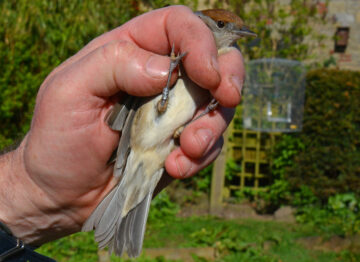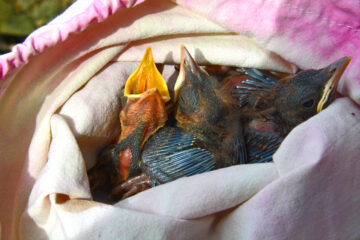Given the current lock-down its been impossible to get out and about to monitor nesting Tawny Owls and Goldeneye or continue with any training. However, I have done a small amount of ringing at home.
The morning of the 4th netted 11 new birds and 11 retraps. The new birds included a beautiful male Bullfinch, several Great Tits, and two Robins. Together with another four Robins included in the retraps I can honestly say that anyone who still thinks they have just one resident Robin in their garden is sadly deluding themselves! Robins were not quite nesting at this point (probably being held back by the cold nights) but clearly the level of antagonism was rising as they were so intent on chasing each other that there were not looking where they were going. One of the retrapped Robins had been ringed back in 2017 and not seen since; another was a female (only hatched last year) with a clearly developing brood patch – so presumably with a nest close-by ready for some eggs.

The morning of the 9th netted only 4 new birds but including a lovely adult female Song Thrush also with a developing brood patch. There were more retraps; 9 in total including six Robins. Trying again on the 10th I captured 4 new birds including a male Blackcap that was probably the same bird that arrived back from North Africa to start singing in our garden on the 5th (see pict.). There were also 6 retraps this morning, including a Robin from 2017, a Dunnock, and some tits.
Throughout this period, we had been regularly observing a pair of Blackbirds that were nesting in a low bush close to both a bird trap and a regular mist net site. I already knew who the female bird was (LK46990; a female hatched only last year) and while the male was not ringed, at this time, he was very recognisable because of having a completely bald head (and being in at least his third year living around our garden). They had four eggs which eventually hatched, and we were able to ring the pulli on the 14th. Clearly, as the demands of these young birds for food increased the parent birds started to get less wary and while they were still cleverly avoiding nets, they both visited a trap to collect food. So, on the 19th ‘Baldy’ male blackbird was captured and became ‘LK46996’ and the female was retrapped again. I have been asked if the male is obviously sick or has parasites to explain his baldness – but I have to say that he appears to be perfectly healthy, despite his odd appearance (see pict.) The young blackbirds fledged sometime around the 22nd April.

On the 19th a total of 9 new birds were ringed including three Goldfinch (who do not seem to be breeding yet) and another new male Blackcap, that seems to have been part of the second wave of multiple individuals that arrived in our patch around the 15th of the month. There were also a Tree Sparrow and a male House Sparrow; the Tree Sparrow clearly showing a chestnut crown and dark cheek patch which distinguishes them from House Sparrows. Around our house, House Sparrows are definitely the rarer of the two species! I also recaptured a Nuthatch, originally ringed in 2016, that seems to have become very bold – coming to feed in our garden regularly while we are working close by. Finally, there was a male Great Tit that I learned (from its ring) is in its 9th year of life at least (the survival record is 10 yrs.).
Ringing at home again on the 24th I captured 5 new birds including a female Blackcap with her distinctive ‘brown’ head cap (see pict.) and a female Tree Sparrow showing a developing Brood Patch. There were also 8 retraps including a pair of Robins, Baldy Blackbird (who has clearly decided that visiting the trap for food is worth the risk) and a Coal Tit with only one leg.
I should be checking on those breeding birds that regularly use small boxes, like tits, Redstarts and sparrows in May but it remains to be seen if any of this will be possible.
Best Regards.
Phil Hanmer S Ringer; Natural History Society of Northumbria Ringing Group (Hancock Museum). E-mail: tytoalbas@btinternet.com